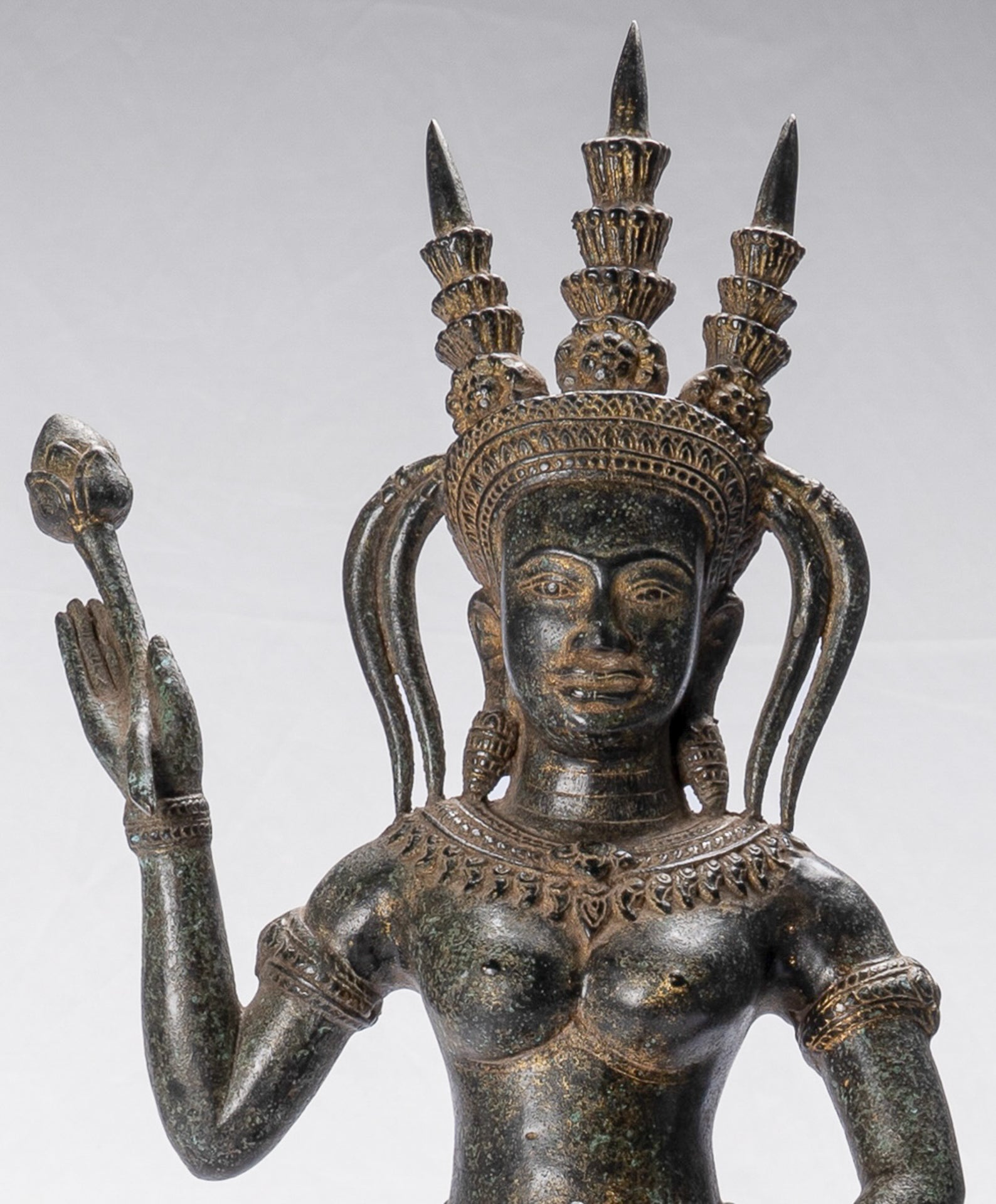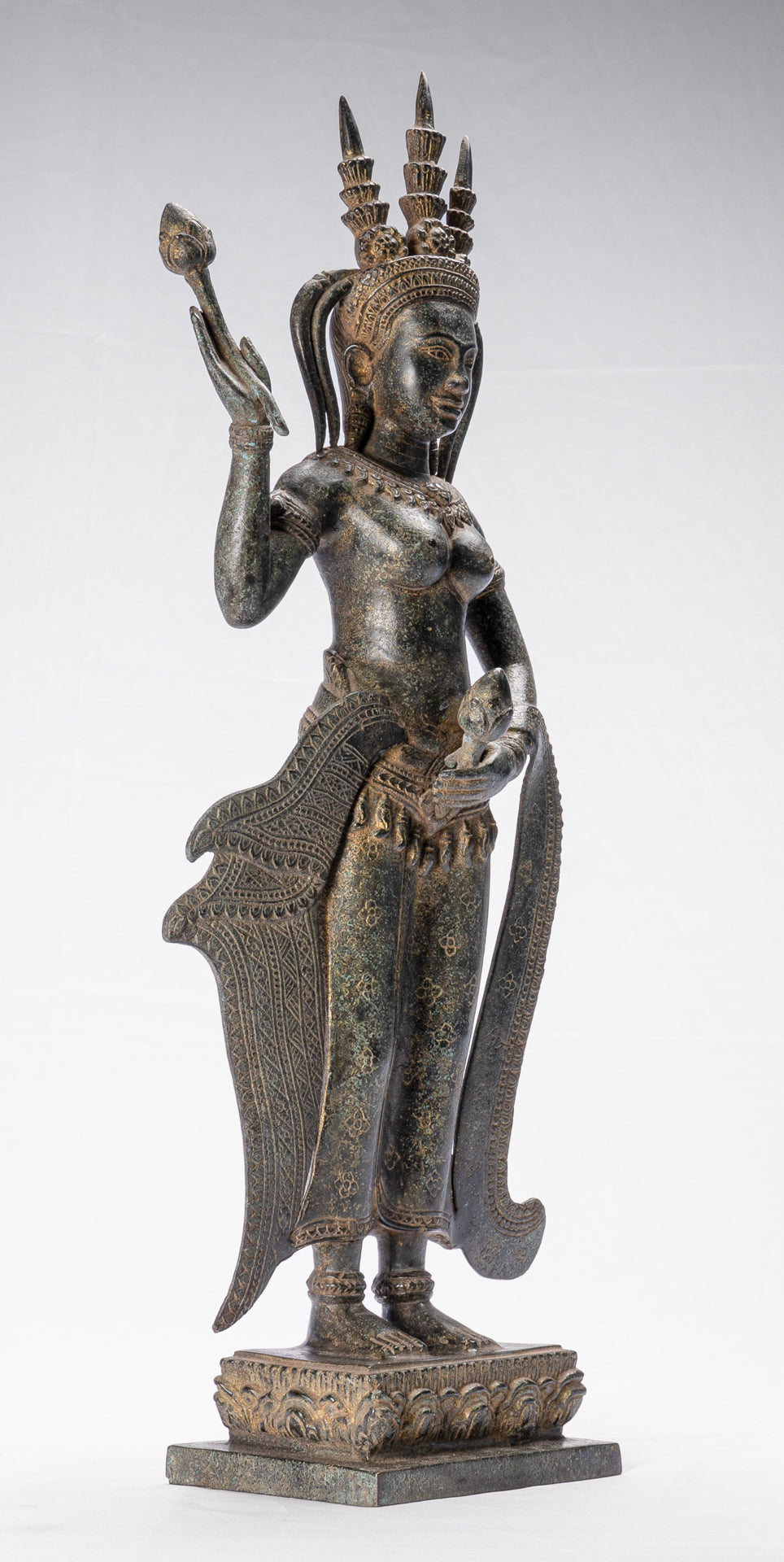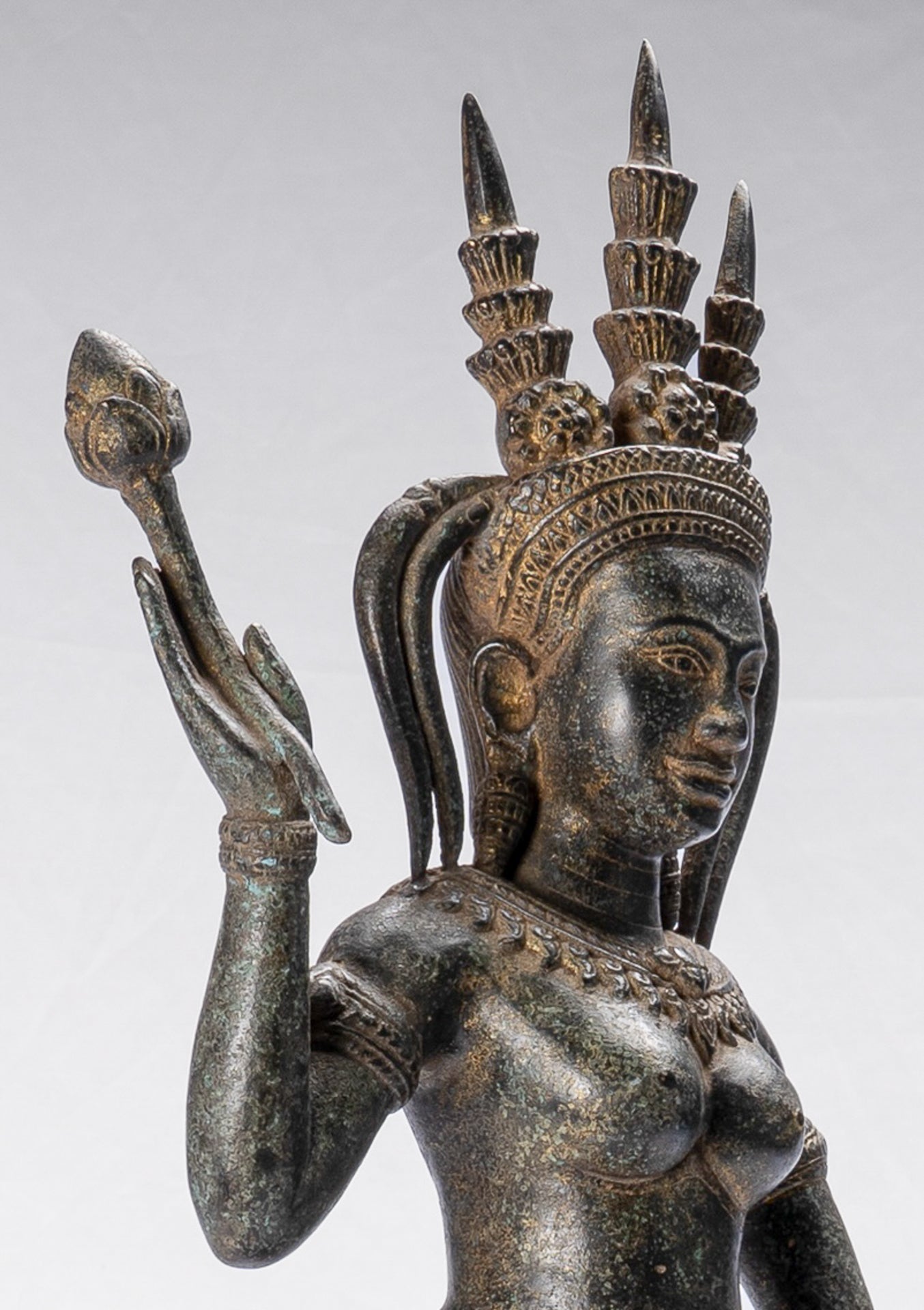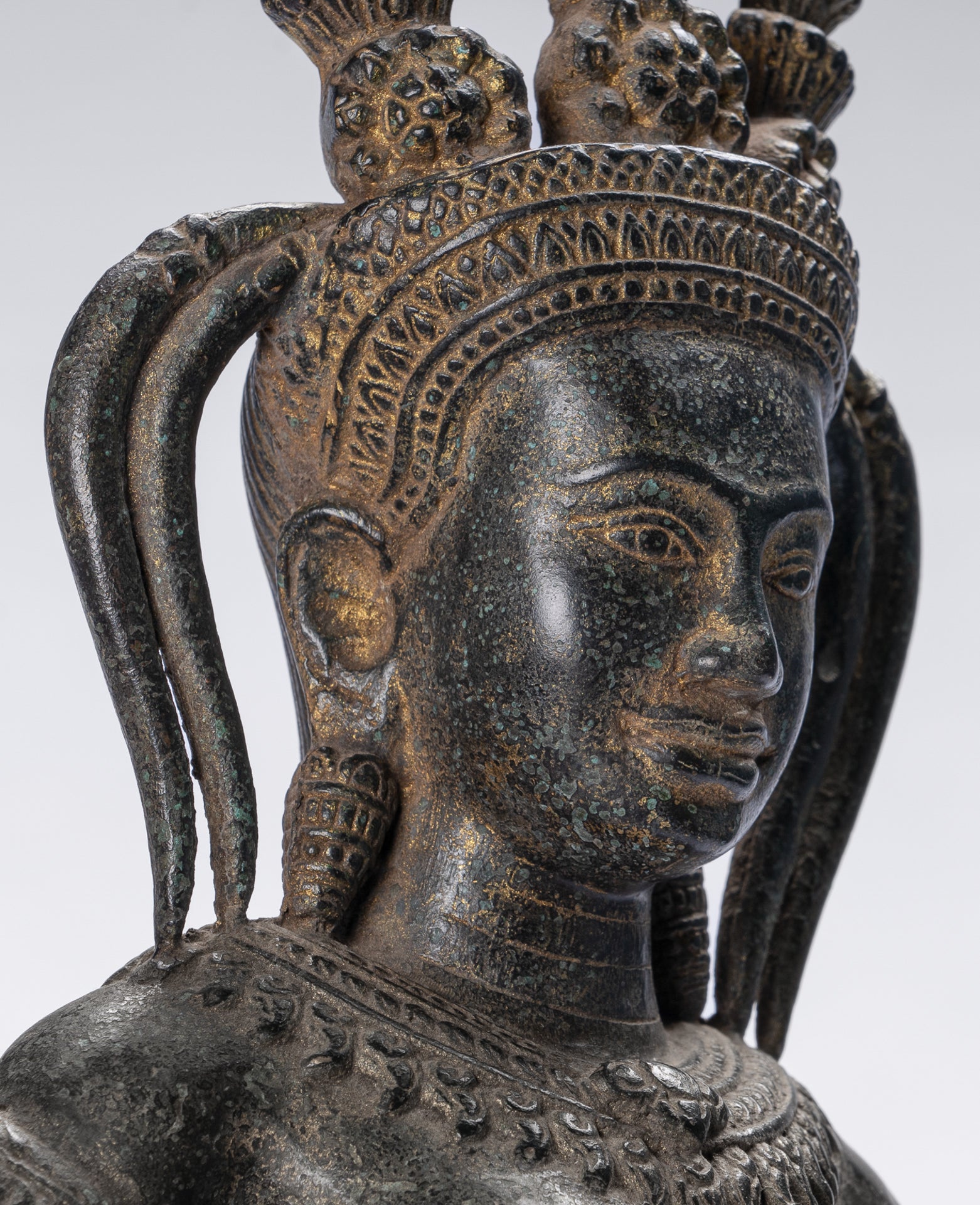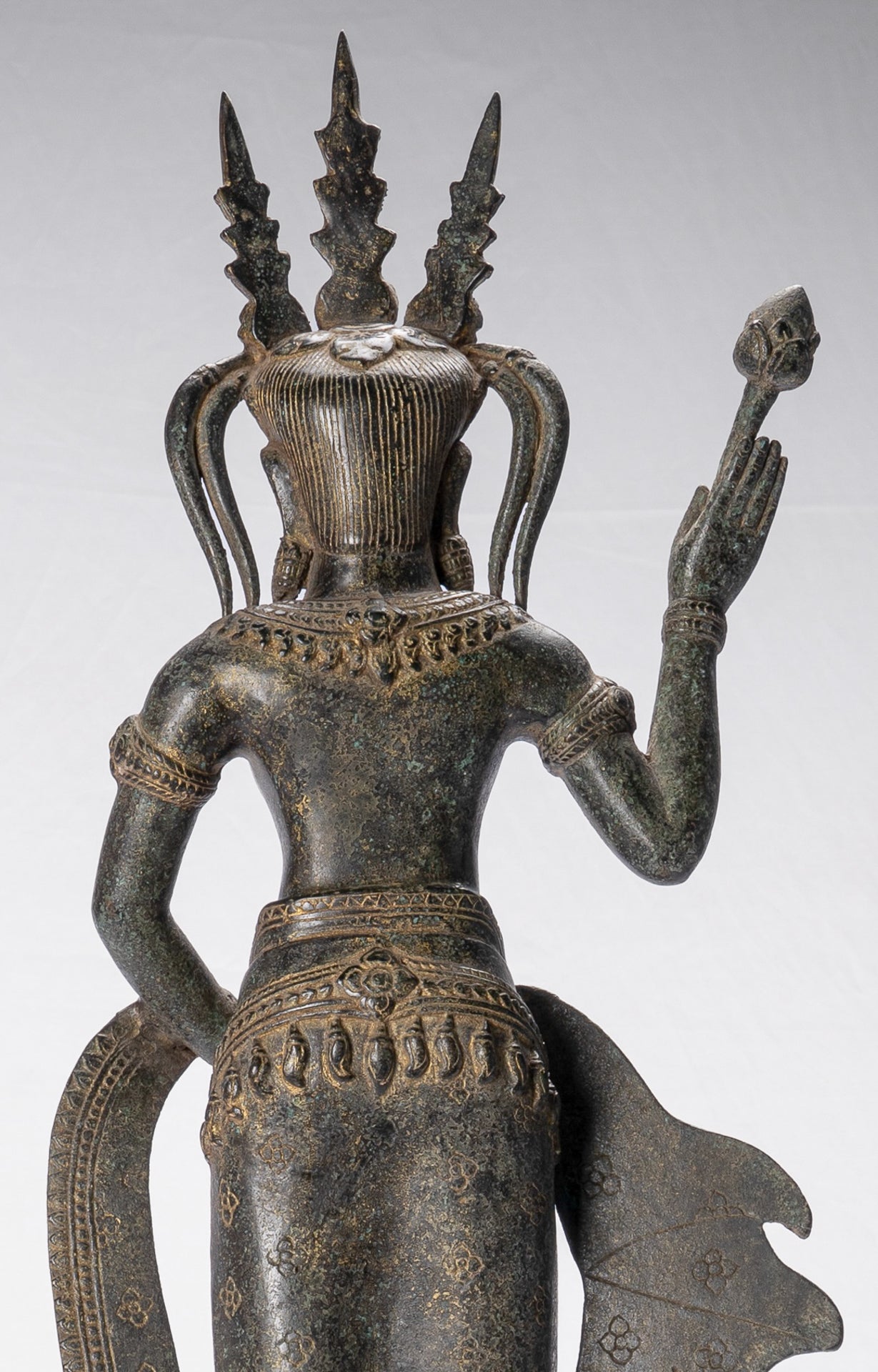-
Antique Khmer Style Bronze Standing Apsara or Angel Statue - 61cm/24"
Measurements Height 61cm/24"
An antique Khmer style bronze standing Apsara or Heavenly angel in 12th century Angkor Wat style.
The Apsara is a female spirit of the clouds and waters in Hindu and Buddhist mythology a celestial nymph or celestial maiden.
The ethereal Apsaras of Angkor Wat are among the most captivating features of this iconic temple complex, gracing its walls with their celestial presence. These divine female figures, elegantly cast in bronze, represent a blend of spiritual symbolism, artistic mastery, and the unique cultural heritage of Cambodia.
As celestial dancers, guardians, and symbols of feminine grace, Apsaras hold deep cultural and religious significance in Hindu and Buddhist traditions alike.
Apsaras are beautiful, supernatural female beings. They are youthful and elegant, and superb in the art of dancing. They are often the wives of the Gandharvas, the court musicians of Indra. They dance to the music made by the Gandharvas, usually in the palaces of the gods, entertain and sometimes seduce gods and men.
As caretakers of fallen heroes, they may be compared to the valkyries of Norse mythology. As etherial beings who inhabit the skies, and are often depicted taking flight, or at service of a god, they may be compared to Angels.
Apsaras are said to be able to change their shape at will, and rule over the fortunes of gaming and gambling. They are also associated with fertility rites.
With the spread of Hinduism and later Buddhism into Southeast Asia, the image of the Apsara was adopted into Cambodian culture, where it evolved into a unique artistic and cultural symbol. In Cambodian tradition, Apsaras are not only celestial dancers but also embody the ideals of feminine beauty, elegance, and grace, making them a prominent feature in Angkorian art.
One of the most remarkable aspects of the Apsaras of the Angkor period are the intricacy and variety of their carvings. Each Apsara is unique, showcasing different hairstyles, jewelry, garments, and postures. This level of detail reflects the advanced skill of Khmer artisans, who were renowned for their ability to imbue their sculptures with life and character.
Key Artistic Elements of Angkor Wat Apsaras:
- Hairstyles and Headdresses: Apsaras are depicted with elaborate hairstyles and headdresses, adorned with flowers, jewels, and complex patterns. Each headdress is uniquely crafted, with multi-tiered crowns, stylized buns, or cascading ornaments, reflecting the Apsaras’ divine nature.
- Jewelry and Ornaments: Apsaras are richly adorned with jewelry, including necklaces, armbands, bracelets, and anklets. These ornaments are rendered with exquisite detail, highlighting the wealth and beauty associated with celestial beings.
- Garments and Drapery: The attire of the Apsaras is depicted with flowing lines and intricate patterns. Their sarong-like skirts and scarves are designed to emphasize the movement of dance, adding a dynamic quality to the carvings. The folds and pleats of their garments showcase the sculptors’ skill in capturing texture and motion.
- Dancing Poses and Expressions: Each Apsara is depicted in a graceful pose, reminiscent of traditional Cambodian dance. With hands and fingers positioned delicately, their stances convey the elegance and fluidity of dance. Their serene expressions enhance the spiritual ambiance, evoking a sense of calm and otherworldly grace.
The artistic details of the Apsaras reflect not only the skill of Khmer sculptors but also the cultural significance placed on these celestial beings. Their ornate attire and graceful poses are symbols of divine beauty, embodying the ideals of femininity and spiritual harmony.
Here, the Apsara holds a lotus flower in her hand. The lotus flower represents purity, compassion and the giving of great joy to all.
The Apsaras of Angkor Wat are more than just exquisite carvings on temple walls; they are symbols of Cambodia’s enduring spirituality, artistry, and cultural identity. Rooted in Hindu mythology yet shaped by Cambodian creativity, the Apsaras embody ideals of grace, beauty, and spirituality that resonate across generations.
As celestial dancers, protectors of sacred space, and icons of divine beauty, these figures remind us of the impermanence of worldly life and the transcendence that can be achieved through devotion and harmony.
Today, they remain a cherished part of Cambodia’s heritage, a lasting testament to the Khmer Empire’s artistic brilliance and the timeless allure of the divine.
Enlighten your modern interior with this stunning antique style Khmer Apsara from HD Asian Art that with traditional design is sure to add an exotic touch to your modern interior. Styled after artistic techniques prevalent in the time of the powerful Khmer Empire of South East Asia.
This traditional in appearance piece is sure to add a unique touch to your home, office or sacred space. One of the most recognisable of the Asian deities this representation of the Apsara is sure to enlighten your home with endlessly timeless style.
-
The majority of orders will be shipped with DHL. This is a secure, express and fully tracked service.
Items less than 2Kg we typically ship using Royal Mail.
Once we receive your order we try to ship all orders the same or next working day.
Large and/or fragile pieces requiring palletising, specialist crating and/or extra packaging may take a little longer. Palletised shipments will be delivered curbside.
All orders over 35 GBP will be shipped free of charge.

-
We genuinely hope that all purchases delight.
However, if they do not, regardless of reason, we will refund all orders upon receipt of the unwanted item. Just notify us within 14 days of receiving your order that you wish to make a return and send the piece back to us with 30 days of delivery.
A wooden Buddha statue is far more than a decorative object; it is a warm, living presence that brings serenity, symbolism, and craftsmanship into any space.
On HD Asian Art, each wooden Buddha sculpture is carefully curated for authenticity, beauty, and spiritual resonance, making every piece a meaningful addition to home, office, or shrine.




